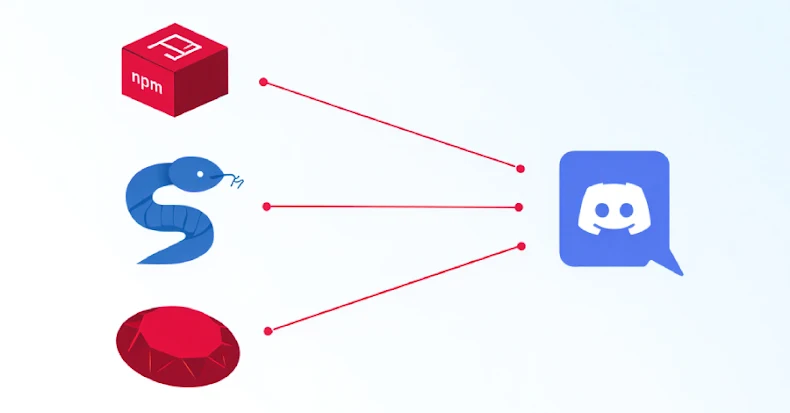Recent investigations have uncovered a series of malicious packages across popular open-source ecosystems—npm, Python Package Index (PyPI), and RubyGems—that exploit Discord’s webhook functionality to exfiltrate sensitive developer data. These findings highlight a growing trend where attackers leverage legitimate communication platforms to establish command-and-control (C2) channels, thereby circumventing traditional security measures.
Understanding Discord Webhooks in Cyber Attacks
Discord, a widely-used communication platform, offers webhooks that allow users to send messages to channels without the need for a bot user or authentication. This feature, while beneficial for legitimate purposes, has been co-opted by threat actors to transmit stolen data to channels under their control. Notably, these webhook URLs are write-only, meaning they do not expose channel history, and defenders cannot retrieve prior posts merely by knowing the URL. This characteristic makes them particularly attractive for malicious activities.
Identified Malicious Packages and Their Operations
The software supply chain security firm Socket has identified several packages that utilize Discord webhooks for various malicious purposes:
– mysql-dumpdiscord (npm): This package extracts contents from developer configuration files such as `config.json`, `.env`, `ayarlar.js`, and `ayarlar.json`, sending the data to a Discord webhook.
– nodejs.discord (npm): While this package uses a Discord webhook to log alerts—a practice not inherently malicious—it demonstrates how such functionalities can be misused.
– malinssx, malicus, and maliinn (PyPI): These packages act as C2 servers by triggering HTTP requests to a Discord channel each time they are installed using the command `pip install
– sqlcommenter_rails (RubyGems.org): This package collects host information, including sensitive files like `/etc/passwd` and `/etc/resolv.conf`, and transmits them to a hard-coded Discord webhook.
The exploitation of Discord webhooks in these attacks is significant because it allows threat actors to avoid the costs and complexities associated with hosting and maintaining their own infrastructure. Additionally, by blending into regular code and firewall rules, these malicious packages can exfiltrate data even from secured environments. When combined with install-time hooks or build scripts, they can silently siphon environment files, API keys, and host details from developer machines and continuous integration (CI) runners long before runtime monitoring detects any anomalies.
The Contagious Interview Campaign: A Broader Threat Landscape
In a related development, Socket has also flagged 338 malicious packages published by North Korean threat actors associated with the Contagious Interview campaign. These packages have been used to deliver malware families such as HexEval, XORIndex, and encrypted loaders that deploy BeaverTail, instead of directly dropping JavaScript stealers and downloaders. Collectively, these packages have been downloaded over 50,000 times.
The campaign employs more than 180 fake personas tied to new npm aliases and registration emails, operating over a dozen C2 endpoints. Targets include Web3, cryptocurrency, and blockchain developers, as well as job seekers in the technical sector. These individuals are approached on professional platforms like LinkedIn with lucrative job offers. Prospective targets are then instructed to complete a coding assignment by cloning a booby-trapped repository that references a malicious package (e.g., `eslint-detector`) already published to the npm registry.
Once executed locally, the referenced package acts as a stealer (i.e., BeaverTail) to harvest browser credentials, cryptocurrency wallet data, macOS Keychain information, keystrokes, clipboard content, and screenshots. The malware is also designed to download additional payloads, including a cross-platform Python backdoor codenamed InvisibleFerret.
Many of these malicious packages are typosquats of legitimate counterparts (e.g., `dotevn` vs. `dotenv`), particularly those related to Node.js, Express, or frontend frameworks like React. This tactic increases the likelihood of accidental installation by developers, thereby expanding the reach of the attack.
Implications and Recommendations for Developers
The discovery of these malicious packages underscores the critical importance of vigilance in the open-source community. Developers are advised to:
1. Scrutinize Package Sources: Before incorporating new packages, verify their authenticity by checking the publisher’s reputation, reading user reviews, and examining the package’s codebase.
2. Monitor Dependencies: Regularly review and update dependencies to ensure they are free from known vulnerabilities.
3. Implement Security Tools: Utilize security tools that can detect and alert on suspicious package behaviors, such as unexpected network communications or data exfiltration attempts.
4. Educate Teams: Conduct regular training sessions to raise awareness about the risks associated with malicious packages and the importance of secure coding practices.
By adopting these measures, developers can better protect their projects and sensitive data from the evolving threats posed by malicious actors exploiting open-source ecosystems.



